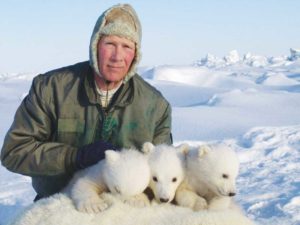
In early December, a video of a dying, emaciated polar bear foraging for food on an iceless land went viral on social media, garnering millions of views on Facebook and YouTube. For most, it was a vivid signal of the future in store for us all due to human-caused (anthropogenic) global warming ― rising temperatures due to increased carbon dioxide, methane, and other greenhouse gases. For those who deny or minimize the existence of anthropogenic global warming, it wasn’t a polar bear but a red herring (“propaganda,” as one YouTube viewer called it). No one knows why it was dying, much less if it can be connected to global warming.
That’s true, but it’s also a bit beside the point.
“The problem is that an ever-warmer future means polar bears will have less and less access to their seal prey, so the rate at which bears die from malnutrition/starvation will increase,” said Dr. Steven Amstrup, chief scientist for the nonprofit Polar Bears International. “So, regardless of the proximate cause of this bear’s condition, this heart-wrenching footage provides us with a warning about the future.”
Just days before the video went viral, a paper Amstrup co-authored presented the polar bear as something else as well: a “keystone domino,” a proxy used to attack global warming.
“Because this evidence [for global warming] is so overwhelming,” he wrote, “it would be virtually impossible to debunk; the main strategy of denier blogs is therefore to focus on topics that are showy and in which it is therefore easy to generate public interest. These topics are used as ‘proxies’ for [anthropogenic global warming] in general; in other words, they represent keystone dominoes that are strategically placed in front of many hundreds of others, each representing a separate line of evidence for anthropogenic global warming. By appearing to knock over the keystone domino, audiences targeted by the communication may assume all other dominoes are toppled in a form of ‘dismissal by association.’ ”
In the paper “Internet Blogs, Polar Bears, and Climate-Change Denial by Proxy,” Jeffrey Harvey, who’s a senior scientist at the Netherlands Institute of Ecology, and 13 co-authors looked at 90 blogs and 92 peer-reviewed papers. The team analyzed them in terms of what they said about sea ice (declining rapidly or not or varying unpredictably over the long run) and polar bears (threatened with extinction or not or capable of adapting to threats).
Another co-author, Bart Verheggen, a climate scientist at Amsterdam University College, starkly described their findings: “There is a clear separation amongst blogs, where approximately half of the 90 blogs investigated agree with the majority of the scientific literature; whereas other blogs took a position that is diametrically opposed to the scientific conclusions. Most of the blogs in the latter group [about 80 percent] based their opinions on one and the same source: Susan Crockford.”
Crockford is an unpaid adjunct professor at the University of Victoria in British Columbia.
There were a few contested papers — ones that drew critical comments after publication — that fell outside the consensus, but they all landed somewhere between the two groups of blogs.
“Our paper was clearly a direct hit because the response from the denial blogs was immediate,” Harvey told me. “As is their modus operandi, they studiously avoid the core messages … . They use a tiny set of topics [proxies] to dismiss anthropogenic global warming. … In attacking the evidence that [anthropogenic global warming] is driving a rapid reduction in seasonal arctic ice extent, [which] threatens polar bears, they almost completely avoid the published scientific literature.”
It’s worth noting that two of Harvey’s co-authors, Amstrup and Ian Stirling, both co-authored more than 20 of the 92 papers in that literature, an indication of their depth of knowledge that was actually held against them by denialists.
The paper, published in the peer-reviewed journal BioScience, also concluded with an unusual call to action: “We believe that it is imperative for more scientists to venture beyond the confines of their labs and lecture halls to directly engage with the public and policymakers, as well as more strongly confronting and resisting the well-funded and organized network of [anthropogenic global warming] denial.”
But global warming denialism is so pervasive it can now be considered a contributing factor to global warming itself — something to be studied and mitigated. This paper is just the latest in the growing field of scientific studies of global warming science and denialist response that’s increasingly causing denialists to squirm.
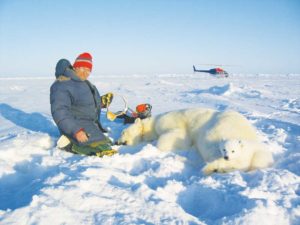
female with cub. Photo Courtesy of Random Length News
This began in 2004, when science historian Naomi Oreskes, a professor of the history of science and affiliated professor of earth and planetary sciences at Harvard University, produced the first of several studies establishing the existence of a solid 97-percent consensus of scientists that humans are responsible for ongoing global warming. It’s also been shown that increasing awareness of this consensus increases public acceptance. In 2015, Norwegian climate scientist Rasmus Benestad pioneered the study of patterns of mistakes across dissenting papers in the remaining 3 percent. These were discovered by trying to replicate their results.
In 2012, Stephan Lewandowsky, a cognitive scientist at the University of Bristol in the United Kingdom and another of Harvey’s co-authors, initiated another line of research. He explored patterns of reasoning in the public at large. He first discovered that belief in a cluster of conspiracy theories was associated with global warming denial. Then he studied the online response of denialists to that study in a paper called “Recursive Fury,” in which he reported that many denialists exhibited at least one of six previously identified characteristics of conspiracist ideation.
The denialists reacted furiously again, and the journal that published the paper withdrew it, not because there was anything scientifically wrong with it but for fear of being sued. This was widely condemned for encouraging scientifically unfounded attacks. Crockford also tried to get Harvey’s paper withdrawn, and others tried to get Harvey condemned by his employer. Both were firmly rebuffed.
Finally, in 2016, sociologist Justin Farrell from Yale University initiated another line of research, using network science and text analysis to investigate the overall structure and organizational power of the contrarian network, including the role of elite corporate benefactors.
Thus, the first two lines of research establish why there’s no credible scientific support for rejecting global warming, while the second two broadly explain the consensus gap between scientists and the public in terms of a combination of individual psychology and sociopolitical influence, with a strong financial component. Harvey’s paper provides a much sharper focus for that broad explanation, leaving little wiggle room for a denialist response short of throwing up his or her hands in surrender.
Denialists, Harvey said, “clearly did not want to respond through the peer-reviewed literature. [Instead they] resorted to three main tactics. The first was to accuse us of ganging up on Susan Crockford, even though she does not appear until Page 3 of the article and is not the primary focus.”
Indeed, Crockford is not even indirectly mentioned in the paper’s abstract.
“They also launched all out attacks on the two most prominent authors, Mike Mann and Stephan Lewandowsky, finally coming around to me after some days,” Harvey said.
Mann was principally responsible for the “hockey stick” graph, the first widely accepted reconstruction of the past 1,000 years of northern hemisphere temperatures, showing dramatic temperature increases in the past few decades, which has made him a prime target for denialist attacks. “Recursive Fury” in particular made Lewandowsky a prime target.
And denialists, Harvey said, have “tried to discredit the paper by criticizing the statistical analyses.”
This was an effort spearheaded by economist Richard Tol, who floundered badly in a similar 2014 attempt to discredit the existence of the 97-percent consensus on global warming.
On the last point, Lewandowsky highlighted what he called the “Monty-Pythonesque” angle of denialists trying frantically to invalidate the scientists’ data.
“The only way to achieve that would be if their blogs didn’t make the claims they clearly insist on making — namely that the Arctic isn’t melting and polar bears are just fine,” Lewandowsky said.
But what the denialists lacked in substance, they made up for in sound and fury, with Crockford herself leading the way. After pointing out the denier blogs’ heavy reliance on her, the paper read: “Notably, as of this writing, Crockford has neither conducted any original research nor published any articles in the peer-reviewed literature on polar bears.”
Crockford, a zoologist who’s been secretly paid by the denialist Heartland Institute, seemingly proved their point by responding with a series of heated blog posts rather than a comment letter to the journal. In one post, she claimed the paper was a conspiratorial response getting back at her for a non-peer-reviewed paper she had published on the web.
In another post, she said that the BioScience article is “academic rape: an assertion of power and intimidation. … Characterizing a professional, respected scientist as an unqualified, vengeful opinion writer is the same kind of power attack as rape. It’s meant to humiliate and intimidate.”
Other denialist blogs echoed her theme, characterizing the paper’s authors as “climate bullies” and harassers.
“Crockford’s claim of academic rape is, in my opinion, really appalling,” Harvey said. “Four of my co-authors are women, including two in their 20s.”
So was Crockford accusing them of rape, too? Or simply erasing their existence?
“Our team has no agenda against a specific blogger,” said Meena Balgopal, associate professor of biology at Colorado State University and another co-author. “We simply found that the majority of the blogs that were identified as ‘climate denying’ referenced Crockford’s blog. Our goal was to use objective methods to better understand how blogs that describe climate change and polar bears present and frame information. Discussions of ‘#MeToo’ or ‘rape’ are, therefore, irrelevant to our study.”
There’s a second element in Crockford’s persecution narrative: Her entry into the half-baked conspiracy theories about the origins of Harvey’s story.
“It’s interesting to see the different conspiracy theories being touted about our paper” on different denialist blogs, Verheggen said.
All of them are wildly wrong, he added. The following are a few of the refuted claims: that Mann and Lewandowsky are behind it all, and they dragged others in with them (from the climate-denier blog WUWT or What’s Up With That, others); that Amstrup and Stirling wanted to get back at Crockford, who criticized them and got others to help them (from Tom Fuller at cliscep and elsewhere); and that a clique around Bart Verheggen and Amsterdam Academia got others to join them in their crusade against “skeptics” (from the Dutch deniosphere at climategate.nl).
WUWT is the most viewed denialist website worldwide. It actually promoted both of the first two conspiracies. Conspiracy theorists often embrace multiple, different, and even contradictory conspiracy narratives. This is one of the six characteristics of conspiracist thought mentioned above, known as “must be wrong,” a pervasive belief that a conspiracy exists despite specific disproofs. Another corollary of this conspiracy thought characteristic is the belief in mutually contradictory theories. The conspiracies listed above aren’t mutually exclusive, but they do illustrate another characteristic of conspiracist thought: “persecution-victimization,” the tendency to see themselves as persecuted victims of the conspiracy, as well as potential heroes. Thus, Crockford and her fans prefer the conspiracy theory revolving around her, and the Dutch denialists prefer the conspiracy centered on Dutch soil.
“Amstrup is pissed off because I criticized his work,” Crockford wrote in a comment at WUWT. “He and Stirling are not used to being challenged.”
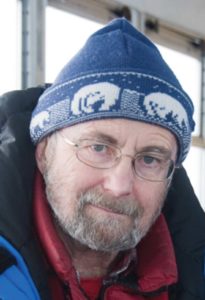
She touted her theory of the BioScience paper’s origins and purpose, based on a paper she published online at PeerJ, which is not a peer-reviewed journal.
Ignoring that fact, she wrote, “Colleagues have read my paper and found it to be fully acceptable as a piece of academic scientific work,” adding that “if that were not true, this desperately ridiculous BioScience paper would never have been published.”
But that’s not how science works. A paper generally has to be peer reviewed and published before other scientists feel a need to respond.
Crockford wrote elsewhere that her paper was “peer reviewed by several well-qualified colleagues before publication (and revised accordingly)” — which is not what “peer reviewed” means — “but was not peer-reviewed again by the PeerJ organization, as is their policy.”
So she knows full well it wasn’t peer reviewed. Was she trying to confuse her non-scientist readers? That was from a blog post containing her “letter to the editors of the journal BioScience requesting retraction of the shoddy and malicious paper by Harvey et al.”
The editors surely saw through this amateurish deception. Just like Donald Trump, she was playing to her base.
That’s hardly her only deception. Elsewhere on her blog, Crockford let her real feelings about BioScience show — feelings so strong they seemed to impair her basic math: “BioScience is an interesting choice for this … paper: I counted only four polar bear research papers in this journal since 2004 but 11 papers on ‘climate change denial’ since 2010 (not including this one). In other words, few polar bear scientists would usually read this journal, but many people interested in the ‘problem’ of ‘climate change denial’ would seek it out.”
Yet it takes only a moment, clicking on the links Crockford provides in the text, to discover she’s totally wrong. There are actually 88 journal articles listed on polar bears and 72 articles classified as research articles. For “climate change denial,” the numbers are 19 and 16, respectively. So she’s wrong both about the journal’s content as well as what people read it for. It is not, as she pretends, a comfy conspiratorial den for her enemies but a well-respected journal of bioscience.
“This kind of harassment, intimidation, and threats are typical, in my opinion, of climate change deniers when they are criticized,” Harvey concluded. “They rarely pursue the normal professional response of writing a rebuttal to a journal until all other options have been exhausted.”
If the point of such proxy controversies is to distract, it’s good to refocus on what it’s being distracted from.
“In addition to the badgering and nitpicking, we’ve been getting more conflation of the present and the future, more about how it has been warm in the past, and more suggestion polar bears will be fine on land,” Amstrup said.
These are all topics well-settled in the scientific literature that are ripe for confusion in the context of a heated proxy fight. The paper explains these confusions, but denier blogs don’t pay attention to scientific literature. Recall that that is the study’s main finding. So Amstrup ticked off what was being obscured.
“Deniers have criticized polar bear scientists because things we projected for later this century have not yet happened,” he said.
That’s the main point of Crockford’s non-peer-reviewed paper, that there are no future threats.
This ignores the known long-term trends and the point Amstrup made about the dying bear video.
“Lowered polar bear survival means more bears are starving to death, so regardless of what happened to cause this particular bear’s problems, we know a future with less ice means higher rates of this kind of event in the future — a future we can avoid by mitigating greenhouse gas rise,” Amstrup said.
He also commented on past warm periods.
“The best evidence suggests we will be far warmer by mid-century than any time in the polar bear’s evolutionary history,” Amstrup said. “The current warming that is occurring over the top of gradually declining insolation is caused by humans and is not at all analogous to past warming events.”
As for polar bears surviving on land, studies show there just isn’t enough nutritious food for them to survive on without access to sea ice, where they can hunt seals. Sure, bears have been known to catch geese, for example, but “there simply are not enough geese to feed all the polar bears if we ultimately let the ice disappear,” Amstrup said.
Of course, the point of the paper is that all the above is well-known to scientists and is deliberately obscured on the denier blogs. The response to the paper helps to prove its point.
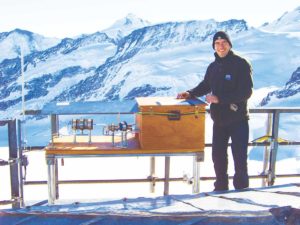
One last response deserves special attention: that of economist Tol, who has made slipshod scientific-sounding arguments before. In a 2014 paper, he criticized one of several studies showing a 97-percent consensus on global warming, arguing it was “only” 91 percent instead.
His paper was rejected twice by one journal for flawed methodology before it was published by another, still with some of the problems reviewers had flagged. A debunking of his claims, “24 Critical Errors in Tol (2014),” written by 10 co-authors, was published at skepticalscience.com, which noted that in his most glaring mistake, he “effectively conjured approximately 300 papers rejecting or minimizing human-caused global warming out of thin air, with no evidence that those papers exist in reality.”
This time out looks strikingly similar. The data issues, once again, are illusory.
“Simply put, there are no issues with the data and Tol doesn’t report any,” Lewandowsky said. “What Tol is doing instead is to throw various innuendos at our particular form of the data and listing the limitations of it. This is a never-ending game of ‘gotcha’ because every type of data has specific limitations, which are taken into account by the appropriate statistical analysis.”
His conclusions are chimeral, too.
Tol wrote that “Harvey et al. (2017) thus really show that there are people who worry about sea ice and polar bears, and those who do not and cite Dr. Crockford.”
Verheggen said that Tol’s description of what the BioScience writers “really show” is “a bit tricky. It’s written in a way that attempts to ridicule and downplay what we did without being outright wrong.”
Peter Roessingh, another co-author and an ecologist at the University of Amsterdam, said that he and his team “not only show there are people who worry and people that do not. … We show that all scientists are in one camp, with half of the blogs, and all other blogs are in the other camp. It is not a random mixture. By omitting the science position, he distorts our conclusion.”
Tol also complained that some of the paper’s co-authors had co-authored a good number of the papers on sea ice and polar bears, which made them biased. He layered multiple misleading arguments to make it seem quite underhanded and nefarious — questioning why only a small subset of papers on polar bears (in the Scopus database) were used, for example.
“There may well be 278 papers on polar bears in Scopus,”
Lewandowsky responded. “In fact, there are probably 10,000 papers in Scopus on bears. And a million on mammals. Holy cow, does this mean we ignored nearly a million relevant papers? Of course not! … He’d get the same number of papers [we did] if he actually used our search terms. … Tol is complaining that the BioScience paper is co-authored by scientists with a high level of relevant expertise. I would call that a strong asset of our paper!”
In short, Tol’s response comes off as the final flourish in a flood of responses, all of which add up to a resounding underscoring of Harvey’s results. As Lewandowsky said, it’s Monty-Python-esque.
“Our paper is hardly surprising, but deniers are angry simply because they have been formally exposed,” Harvey summed up. “It is patently obvious that denier blogs are master cherry pickers of quite dubious sources. They know it too, but they just don’t want to admit it.”
This is why the paper’s call for scientists to become more engaged on social media is so crucial. The more of them there are, the harder it will be for the cherry pickers to win when the next viral video comes around.
Paul Rosenberg is the senior editor for Random Lengths News in Los Angeles and a contributing columnist for Salon.com. This article is copyrighted by Random Lengths News as a special reprint for member publications of the Association of Alternative Newsweeklies.



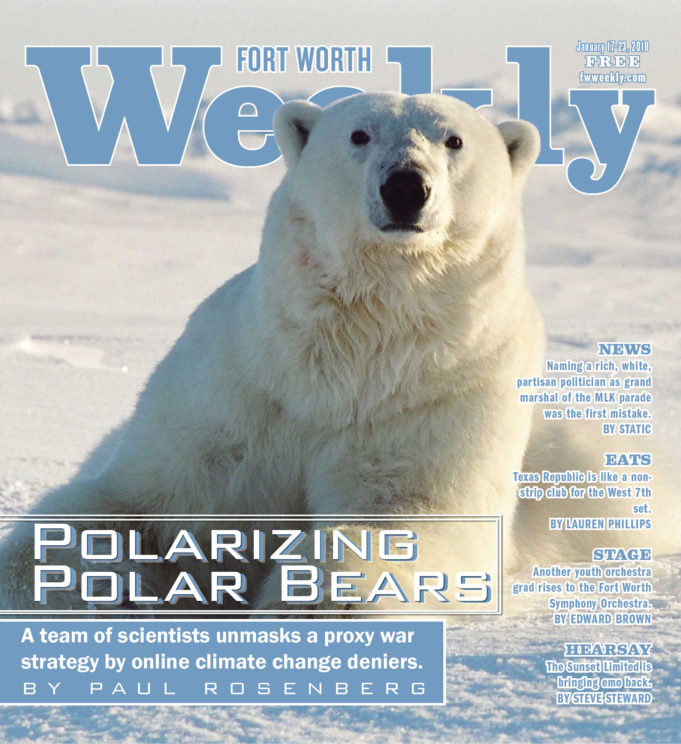









Wow. A local story.
This is the most dishonest article I’ve seen this month.
Firstly, look at the slander ‘denialist’. This epithet was created specifically to smear by false analogy with Holocaust deniers. Then look at the fact the whole argument is sophistry based on the ad hominem error.
The conspiratorial accusations about the ‘the well-funded and organized network of [anthropogenic global warming] denial” ‘ founders on the fact that there is no such thing. Every attempt to prove this eco-loon delusion has ended up in embarrassed failure.
See how Rosenberg et al criticise the person, not the evidence. This is the ‘100 scientists against Einstein’ school of pseudo-science, played again. They attack Susan Crockford and Richard Tol, rather than the work of Crockford and Tol. The reason they don’t attack the work is that that work is correct.
The only factual issue the article addressed was that the Polar Bear was not killed by Global Warming. In this case too, as the article confesses, as far as the facts are concerned, the sceptics were in the right.
Tol, among many other valuable contributions to the discussion, is one of the many who (rightly) pointed out the IPCC cost/benefit calculation of CO2 failed to include the benefits under the ‘Social cost of carbon’.
Crockford’s offence was to compare the actual numbers of polar bears with the predicted numbers and to show the predictions were wrong. What she has done is science. What Rosenberg is doing is blaming the messenger for bearing good news!
See how the eco-loons ignore that the sceptics have been proven correct. The ‘Global Warming = Armageddon’ crowd were, as consistently alleged, alarmist and their predictions exaggerated. Still adamantly treating as secular holy writ the models used by the IPCC, they don’t acknowledge that the modellers themselves, have reduced their predictions. Having seen how reality fails to agree with their predictions, have revised their models. They now conclude the world can release three times as much CO2 as they originally calculated for a given change of temperature. That conclusion, by ten modellers, Millar et al, was published in nature geoscience on 18 September 2017. Good news for everyone except alarmists, eco-activists and eco-journalists such as Rosenberg.